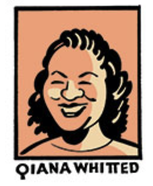 Originally posted at Pencil Panel Page. Earlier this week, in a review of African American Classics, the latest volume from the Graphic Classics series, I made this claim about comics adaptations of African American literature: These “graphic” adaptations elevate the visual field of representation in ways that should remind us that literary expressions of African American experience have always been deeply entrenched in the realm of social perception, spectacle, and visibility. The works were originally written to counter claims that the entire character of a people could be arbitrarily determined by what is seen, from skin color to physiognomy to a so-called drop of Negro-stained blood. African American Classics, then, returns the counter-argument of its featured stories to their visual origins and exposes the absurdity of race prejudice in a way that only a comic can. This assertion about the fundamentally visual nature of black literary and cultural production is one that I think deserves more attention in the field of comics studies. But lately I’ve been thinking about ways to experiment with this claim, and about how the profound explorations of racial constructs by a writer like Toni Morrison may offering a thrilling exception to the rule. “They shoot the white girl first,” is the opening line of Morrison’s 1998 novel, Paradise. The first chapter details the murder of five female outcasts living on the outskirts of a small town in Oklahoma during the 1970s and the remainder of the novel details why. What we are never told, however, is which one of the women is white; the group is made up primarily of black women and it is clear that race matters in their relationships, but this aspect of their identity is subsumed in a collective alienation that is based on all sorts of conflicting assumptions about their gender and sexuality, their political commitments and morals.  Originally posted at The Hooded Utilitarian. African American Classics is the twenty-second volume of Graphic Classics, an independently-published series that has previously featured comics adaptations of works by writers such as Edgar Allan Poe, Mark Twain, Oscar Wilde, and O. Henry. The earlier selections indicate a predilection for suspense, fantasy, and adventure – genres that traditionally have had a strained relationship with the high literary establishment, but whose vivid narratives are particularly well suited for the comics form. Nevertheless, the series takes part in a different kind of conversation when the term “classics” is applied to the poetry and prose of Paul Laurence Dunbar, Langston Hughes, Zora Neale Hurston, and other African American writers. Too often dismissed outright as provincial and derivative, African American literature has struggled with questions of legitimacy since Phillis Wheatley published her book of poems in 1773. “Among the blacks is misery enough, God knows, but no poetry,” Thomas Jefferson wrote eight years later. “Religion indeed has produced a Phyllis Whately but it could not produce a poet.” The Harlem Renaissance coalesced around a determination to prove Jefferson wrong through the shrewd circulation and celebration of black cultural production (not only in Harlem, but Washington, DC and Chicago too). Anthologies like Alain Locke’s seminal 1925 collection, The New Negro, as well as awards, collaborative journals, and art exhibitions brought together the most promising African American talent, with black writers like James Weldon Johnson making explicit the stakes of their work: “The status of the Negro in the United States is more a question of national mental attitude toward the race than of actual conditions. And nothing will do more to change that mental attitude and raise his status than a demonstration of intellectual parity by the Negro through the production of literature and art.” The creative appeals of this late-nineteenth and early twentieth-century racial uplift ideology are widely reflected in the literature chosen for African American Classics. A representative selection is Florence Lewis Bentley’s story, “Two Americans” (1921), illustrated by Trevor Von Eeden and adapted by Alex Simmons, in which a black WWI soldier in France rescues an injured white soldier who led the lynch mob that killed his brother, Joe, back in Georgia. Initially the outraged black soldier leaves the white man on the battlefield to die, but then Joe’s spirit appears: “He made me know that all men are brothers, black, white, yellow and brown… and that if I killed in hatred, I would be killing Joe again… just as that white mob did” (21). The comics anthology draws heavily upon stories like these, finely-crafted works aimed at educating readers about the far-reaching costs of racial injustice, often against a backdrop of African American moral exceptionalism, class consciousness, and a deep engagement with the past that is at turns admiring and uncertain. |
AboutAn archive of my online writing on comics, literature, and culture. (Illustration above by Seth!) Categories
All
Archives
July 2020
|

 RSS Feed
RSS Feed